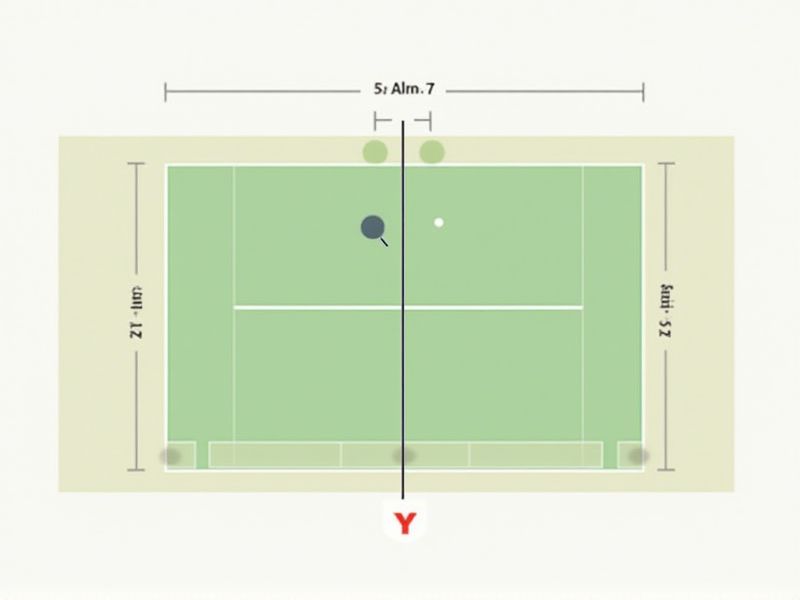
When setting up a pickleball court, knowing the standard dimensions is essential for optimal play. A regulation pickleball court measures 20 feet wide by 44 feet long for both singles and doubles matches. The net height is 36 inches at the sidelines and 34 inches at the center, providing just the right balance for gameplay. These measurements mirror a badminton court and help ensure consistency and fairness, whether you're playing recreationally or in a tournament setting.
Court Length: 44 Feet
The official length of a pickleball court measures 44 feet, accommodating both singles and doubles play with a width of 20 feet. This precise dimension ensures an optimal playing area, allowing for strategic rallies and dynamic gameplay. The court is divided by a net, set at a height of 36 inches at the sidelines and 34 inches in the middle, fostering fair competition. Understanding these measurements is crucial for proper court setup and enhances your overall playing experience.
Court Width: 20 Feet
A standard pickleball court measures 20 feet in width, ensuring ample space for players to maneuver effectively. The total length of the court reaches 44 feet, creating a well-proportioned area for singles or doubles matches. The net height stands at 36 inches, allowing for a fair challenge while maintaining the fast-paced nature of the game. Knowing these specifications can help you set up a regulation court for competitive play or recreational enjoyment.
Non-Volley Zone (Kitchen): 7 Feet From The Net
The Non-Volley Zone, commonly referred to as the "Kitchen," is a critical area in pickleball, situated 7 feet from the net on both sides of the court. This 14-foot-wide zone plays a pivotal role in gameplay, prohibiting players from volleying the ball while standing inside it, thereby promoting strategic shot placement and positioning. Understanding this regulation is essential for enhancing your skills and ensuring fair play. By mastering the dynamics of the Kitchen, you can significantly improve your offensive and defensive tactics on the court.
Service Courts: Two On Each Side Of Net
A standard pickleball court features a service area divided into two service courts on each side of the net, measuring 10 feet wide and 15 feet deep. The service court lines are positioned 21 feet from the net, demarcating the area players must use to perform their serve. Proper serving technique requires you to strike the ball below your waist and ensure it travels diagonally into the opponent's service court. Understanding these dimensions is essential for optimizing your gameplay and adhering to the official rules of pickleball.
Baseline Distance: Back Boundary Of The Court
The standard distance of the baseline in pickleball courts measures 20 feet from the back boundary to the net. This crucial measurement ensures a consistent play area for both singles and doubles matches. The overall court dimensions, comprising a length of 44 feet and a width of 20 feet, create a balanced playing field. If you're considering setting up a court, adhering to these standards is essential for optimal gameplay and competitive play.
Net Height At Sides: 36 Inches
The standard height of a pickleball net at the sides is precisely 36 inches, ensuring consistent play across various courts. This measurement is crucial for maintaining the integrity of the game, as it influences both the bounce of the ball and player strategies. The center of the net is slightly lower, measuring 34 inches, which contributes to the unique dynamics of pickleball. Understanding these specifications can enhance your overall experience and performance on the court.
Net Height At Center: 34 Inches
The standard height of a pickleball net at the center is 34 inches, ensuring a consistent playing experience across courts. Official pickleball regulations dictate that the net should be slightly higher at the sidelines, measuring 36 inches, to account for the natural sag of the net. This difference enhances gameplay, allowing for a balanced competition while accommodating varying shot types. For your optimal play, make sure your pickleball court adheres to these specifications to maintain compliance with official tournaments.
Sidelines: Boundaries For Singles And Doubles
The official dimensions of a standard pickleball court measure 20 feet wide by 44 feet long for doubles matches, while singles play utilizes the same length but narrows to 20 feet wide, emphasizing the importance of boundaries. Each side features sidelines that define the out-of-bounds area, ensuring clear delineation for scoring and play. The non-volley zone, or kitchen, spans 7 feet from the net, critical for maintaining the integrity of the game by preventing players from executing volleys within this space. Understanding these guidelines allows you to enhance your gameplay strategy with precision and accuracy.
Centerline: Divides Service Courts
The standard pickleball court measures 20 feet wide and 44 feet long, designed for both singles and doubles play. The centerline, which runs parallel to the net, divides the service courts into two equal parts, each measuring 10 feet wide. This critical line ensures that players serve diagonally into the opposite service court, promoting fair play and strategy in the game. Understanding the significance of the centerline is essential for maximizing your performance on the court.
Surface Type: Hard, Textured Material
The standard pickleball court features a surface type made of hard, textured materials that promote optimal ball bounce and player traction. Typically, these surfaces are constructed from acrylic or polyurethane, providing durability and smooth playability. Courts are usually 20 feet wide and 44 feet long for doubles play, ensuring adequate space for movement and strategy. Regular maintenance of your court surface is essential to retain its high performance and safety standards.
